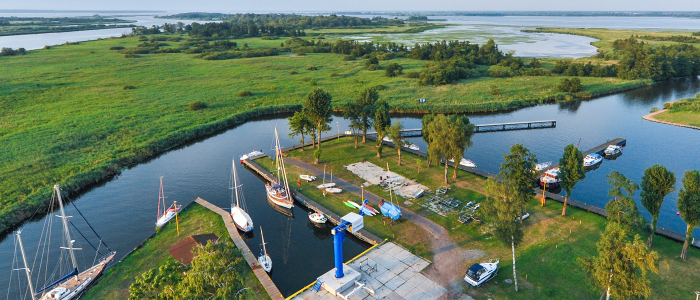Lower Oder The lower part of the Odra river splits into two branches – West Oder and East Oder (Regalica). Its depth varies depending from the river level. It is usually about 2-3 m deep in the mainstream. While sailing these waters, you must take the flow into consideration, which also is dependent on the river level. Bridges are potential additional obstacles, considering that you will have to pass under them. The highest a ship can at most be, in order to pass under all bridges, is 4 m – and this too depends on the river level. Fairways in both of these branches of the river are well marked during the day. On the way from the village Widuchowa, you can stop in ports on both the German and the Polish side of the river. While gently flowing with the Oder’s current, you will experience peace and serenity in the surroundings of nature. You will be flow through the Lower Oder Valley National Park, where you will be accompanied by white-tailed eagles, ospreys, black kites, and short-eared owls. You can also meet beavers, otters, and many other animals. Having bought a permit, you can go fishing. If you’re lucky, you can catch such fish as bream, pike, eel, tench, carp, catfish, and zander. Sailing into the Szczecin Lagoon from Szczecin, you will have the opportunity to recall maritime pilotage, as well as daytime and night-time marks and signals for ships. Lake Dąbie The fourth largest Polish lake. Its average depth is 2.5 m; you can safely sail on the lake on a centreboard yacht or a small yacht with ballast built into the hull bottom. Its water area is well marked during the day, yet at night only the ports in its southern part are marked. While navigating these waters, you have to be especially careful of the numerous fishing nets, which are, in most cases, designated by appropriate marks. The weather on the lake is unstable but, since the waves are not very big and you can quickly find shelter, you can sail here without any major worries. The lake offers a plurality of channels connecting it to the Oder that give you a feeling as if you were in Masuria. Some of them are no-noise zones. There are many islands between the channels, where you can stop, but not at all of them. You can also anchor to Dąbie’s reed-covered shore. In the northern part of the lake, you can find an immersed concrete barge, which is one of the distinctive places on the lake. In the southern part of the lake lies the majority of Szczecin’s marinas, from which you can get to the centre of Szczecin by bus. The Szczecin Lagoon It is a well sheltered body of water with an average depth of 3.8 m, but you have to be careful of numerous shoals and fishing nets. The lake can be navigated on both centreboard yachts and small yachts with ballast built into the hull bottom. Larger yachts (which are limited by their draught) should move along the Szczecin-Świnoujście fairway. The fairway and the approaches to the ports are well marked both day and night. On the fairway, professional ships have priority over other vessels. With strong wind waves develop very quickly – wave height reaches 1.5 m with a Beaufort wind force of 8. When the wind stops, the wave disappears as soon as it was formed. The waves are short and steep, but do not pose a big threat. In bad weather, do not stray away from the Fairway. While sailing on the Szczecin Lagoon, you should possess updated maps and navigational aids, and a VHF radiotelephone. From these waters, you can enter many Polish and German ports. You can also sail to Szczecin, or to the Baltic Sea – by Piana, Dziwna or Świna. The Bay of Pomerania A bay of the Baltic Sea, located in its south-eastern part, off the shores of Poland and Germany. Its northern boundaries are established by a line connecting Cape Arkona on Rügen island with the Gąski Lighthouse (Latarnia Morska Gąski), east of the city of Kołobrzeg. The bay’s depth does not exceed 15 m. You can, without fear, navigate these waters on a small yacht with ballast built into the hull bottom. A properly prepared and courageous centreboard yacht is another option – when accompanied with a favourable weather and moving in short hops. Along the Polish coast, you can take refuge in a number of ports (30 NM apart at most). The entrances to the ports lying along the bay are well marked both day and night. While sailing east from Świnoujście, you should be careful of the fishing nets present along virtually the entire coast at a distance of about 3NM from the shore. Weather on the bay’s waters is unstable. During summer, you can expect frequent tempests as well as storms lasting for a few hours, followed by a long period of calm. During spring and autumn, storms can last a few days. Wave height increases with wind speed – reaching up to about 4 m with a Beaufort wind force of 6 blowing from the direction of the sea. The waves are relatively short but they can become a nuisance for the crew. Swell is a frequent phenomenon here, particularly after periods of stronger winds. With the wind blowing from the mainland, there are practically no waves at all. In cases of wind power forecasts predicting more than 5 points on the Beaufort wind scale, it is better to postpone any plans to sail against the wind, remain in port, and wait out unfavourable conditions. While sailing in the Pomeranian Bay, you should have reliable navigational instruments and complete safety equipment.
We use cookies to ensure that we give you the best experience on our website.







